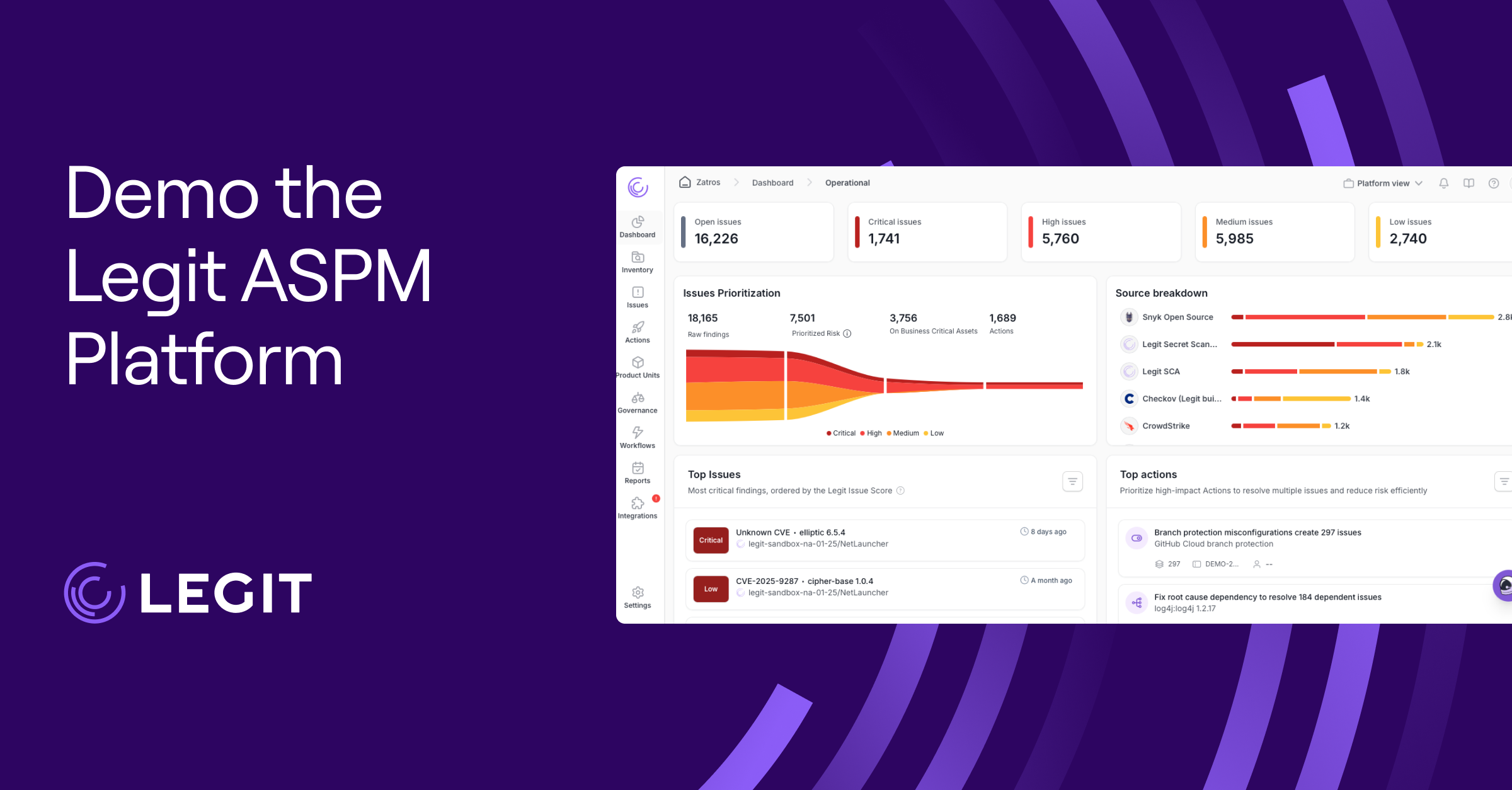Cybersecurity compliance isn't a once-a-year checklist. For companies navigating tight regulations, complex compliance management, and fast-moving development cycles, it needs to be ongoing.
That’s where continuous compliance comes in. It's a shift from a reactive to a proactive model, where compliance is built into how your business operates across teams, tools, and timelines.
This article will explain continuous compliance and how to incorporate it into your day-to-day operations.
What Is Continuous Compliance?
Continuous compliance helps security teams align with regulatory compliance policies and internal standards without waiting for an audit to trigger action.
Instead of scrambling to gather evidence at the last minute, businesses use continuous compliance monitoring to maintain real-time visibility across systems and processes. The goal is simple: make compliance part of daily workflows. This way, you're always ready to comply with regulatory requirements, not just when an auditor shows up. You can detect non-compliance issues as they emerge and address them before they snowball into audit failures or security gaps.
Continuous compliance strategies include automated monitoring, real-time alerts, and consistent documentation—all of which remove the guesswork and burden of manual processes. In software development environments, this often includes tracking the software bill of materials (SBOM) and package integrity as part of a broader continuous compliance and SBOM strategy, ensuring compliance extends across the entire build and release process.
Benefits of Continuous Compliance
Adopting continuous compliance fundamentally changes how your organization approaches risk, audits, and day-to-day operations. Below are some key benefits of moving from periodic checks to a continuous model:
Real-Time Visibility
Point-in-time audits can’t keep up with dynamic environments. Continuous compliance offers ongoing insight into your compliance status across systems, controls, and workflows. Continuous compliance monitoring flags issues the moment they surface, not months later when they've already spread.
Better Security
Strong security and compliance go hand in hand. When monitoring is continuous, so is your ability to detect misconfigurations, access violations, or policy drift before they lead to real damage.
This is especially relevant in fast-moving development environments, where data protection and compliance must work together. Teams often face compliance challenges in AppSec that require visibility and coordination across engineering and security.
Predictable Costs
Periodic audits often include fire drills, emergency fixes, and blown budgets. Continuous compliance distributes effort over time and avoids the expensive disruption of seasonal panic. With better visibility into controls and gaps, you can plan ahead, allocate resources wisely, and reduce the cost of maintaining your regulatory compliance policy.
Audit-Readiness
Preparing for an audit doesn’t need to drain your team. Continuous compliance integrates evidence collection and policy tracking into day-to-day operations, so audits become a checkpoint, not a crisis. Security teams can comply with the regulations that apply to their industries with less stress and less disruption.
A streamlined audit process also improves efficiency and helps avoid last-minute surprises. Knowing the types of security audits your organization is subject to can help tailor your approach and minimize surprises.
Competitive Edge
Whether you're selling into FinServ, healthcare, or software as a service (SaaS), proving real-time compliance can accelerate vendor reviews and close deals faster. Demonstrating that your compliance and regulation practices are continuous—not occasional—builds trust and strengthens your reputation with customers and partners.
Cultural Shift Toward Accountability
One of the most overlooked benefits of continuous compliance is the mindset it encourages. By embedding compliance into daily workflows, employees understand how their actions impact audit readiness and security. This shift moves ownership beyond the security team, creating shared responsibility across engineering, operations, and business units to comply with regulatory requirements more effectively.
Key Components of Continuous Compliance
Continuous compliance requires a foundation of controls, automation, and visibility that supports enforcement across teams. The components below work together to keep your compliance posture intact as your environment evolves:
- Real-time alerts and notifications: Staying ahead of compliance drift means knowing the moment something goes out of bounds. Real-time alerts give you immediate insight into unusual access patterns, policy violations, or configuration changes so you can fix problems before they escalate into incidents.
- Granular access controls: Access rights are among the most common sources of compliance gaps. Reduce risk by applying least privilege principles and managing permissions with fine-tuned policies while aligning with IT security frameworks. This precision ensures users only access what they need and nothing more.
- Automated audit logging and reporting: Continuous compliance depends on your ability to track and prove what's happening across your environment. Systems that log every access request, change, and command create a detailed, time-stamped trail. This is indispensable for passing audits and demonstrating compliance with regulatory requirements over time.
- Zero-trust architecture: Trust nothing and verify everything. This approach reinforces compliance by continuously validating user identity and access regardless of location, role, or device. It's especially useful in hybrid or remote environments where traditional perimeter-based security falls short.
- Policy enforcement and automated compliance checks: Writing a policy isn't enough. Enforce it across the board. Automated tools can enforce policy directly within infrastructure, scanning for violations and remediating misconfigurations without waiting for manual reviews.
- Unified access and visibility: Scattered systems and siloed data complicate compliance. A centralized platform for managing and auditing access across databases, servers, and clusters simplifies oversight. This approach supports broader application security posture management by helping you enforce compliance policies throughout the SDLC.
4 Steps to Implement Continuous Compliance
Getting started with continuous compliance doesn’t have to mean overhauling everything at once. These foundational steps help you build a program that’s proactive, scalable, and built to last:
1. Assess Your Current Posture
Start by identifying which regulations apply to your business and evaluating how well current processes, systems, and controls align. A risk assessment surfaces gaps that may impact compliance and supports broader risk management efforts.
2. Define and Document Your Policies
Update or create a clear compliance policy that reflects regulatory requirements and internal standards. This should outline how you enforce, monitor, and maintain organizational controls.
3. Automate Monitoring and Evidence Collection
Manual processes can’t keep pace with modern compliance demands. Use tools that support automated compliance checks, continuous monitoring, and centralized evidence collection to reduce overhead and improve accuracy.
4. Train Teams and Review Regularly
Everyone plays a role in compliance. Train relevant teams on policy expectations and review your compliance program regularly to keep pace with changing regulations, tech stacks, and risk profiles.
Best Practices for Achieving Continuous Compliance
Clear policies, shared accountability, and continuous refinement best facilitate continuous compliance. These best practices keep your program consistent and scalable—no matter how complex your environment becomes.
Identify and Map Compliance Standards
Start by identifying all applicable frameworks and standards, such as the International Organization for Standardization 27001 (ISO 27001), the Payment Card Industry Data Security Standard (PCI DSS), and SOC 2, and building a unified internal control set. Mapping requirements across overlapping frameworks minimizes redundant testing and streamlines audits without sacrificing coverage.
Conduct Regular Internal Assessments
Waiting for external audits to uncover compliance gaps puts you on the defensive. Instead, play offense and spot gaps before they become problems. Regular compliance audits and risk assessments evaluate existing controls, test their effectiveness, and uncover hidden vulnerabilities in access or vendor integrations.
Document and Communicate Clearly
If you can’t prove it, it didn’t happen. Documentation—access logs, policy updates, control changes—serves as evidence during audits and tells teams how their responsibilities connect to compliance goals. Clear, shared documentation strengthens both accountability and response.
Automate Monitoring and Attestation
Manual checks can’t scale across dynamic workloads. Use automation to continuously monitor controls, collect evidence, and trigger reminders for periodic attestation. This reduces overhead while keeping control owners engaged and informed.
Promote a Culture of Continuous Accountability
Technology alone doesn’t create compliance—people do. Train employees on compliance expectations, make sure stakeholders know which standards apply to them, and reinforce why their role matters. Over time, this builds a culture where compliance is a shared responsibility.
Improve Compliance From Code to Cloud With Legit Security
Legit Security supports continuous compliance by embedding security into every stage of your software development lifecycle. With real-time monitoring, automated vulnerability detection, and regulatory drift alerts, Legit ensures your security controls align with frameworks like ISO 27001, SOC 2, PCI DSS, and NIST.
Map policies to specific regulations, generate signed SBOMs and attestations, and track the security posture of every release. Legit's Software Compliance and Attestation Trust Center reinforces these capabilities by bringing transparency and trust to your team's compliance management. Request a demo to learn more.
Download our new whitepaper.


